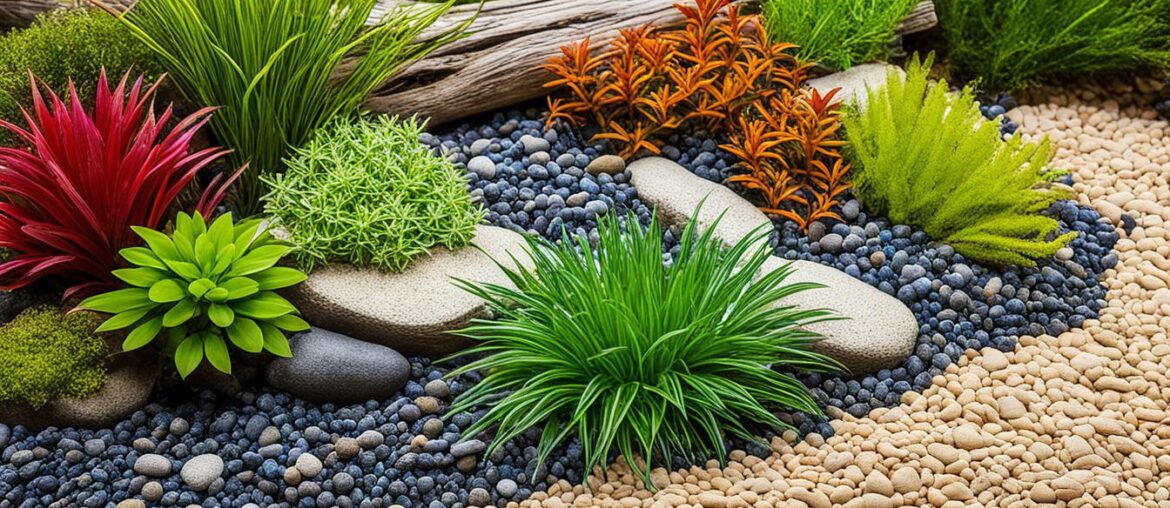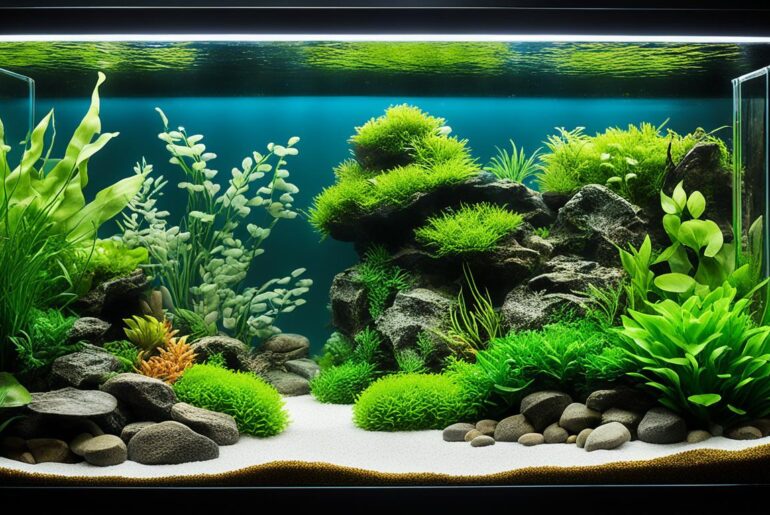As an avid aquarium enthusiast, I’ve always sought ways to enhance the beauty and functionality of my freshwater tank. One aspect that I’ve come to appreciate is the importance of the substrate. It not only supports plant growth but also provides a surface for beneficial bacteria colonization, creating a thriving environment for my aquarium livestock.
While there is a plethora of aquarium substrate options available in the market, I’ve discovered the joy of creating my own DIY substrates. Not only does it save me money, but it also allows me to customize the substrate to suit the specific needs of my tank. From homemade aquarium substrate to creative DIY fish tank substrates, the possibilities are endless.
Join me as I take you through five simple steps to create your own DIY substrates that will not only enhance the natural beauty of your freshwater tank but also promote the overall health and well-being of your aquatic ecosystem.
Key Takeaways:
- Creating DIY substrates for freshwater tanks saves money and allows for customization.
- Substrate supports plant growth, beneficial bacteria colonization, and provides a conducive environment for aquarium livestock.
- DIY substrate ideas include topsoil and clay mixture, clay cat litter, garden soil, backyard soil, and sand.
- Avoid using substances like peat, dyes, scents, pesticides, fungicides, or cleaning chemicals in DIY substrates.
- Maintain DIY substrates through regular monitoring, proper cleaning, and preventive measures.
Purpose of Substrate in Freshwater Tanks
Substrate plays a crucial role in freshwater tanks by supporting plant growth, providing a surface for beneficial bacteria colonization, and enriching the environment for aquarium livestock. Having the right substrate is essential for a thriving and healthy aquarium ecosystem.
Supporting Plant Growth
Plants require a stable and nutrient-rich substrate to root and grow properly. A suitable substrate provides anchorage for the plants, allowing them to establish a strong foundation. It also serves as a reservoir for essential nutrients and minerals, which are vital for plant growth and development.
Beneficial Bacteria Colonization
Substrate offers a large surface area for beneficial bacteria to colonize. These bacteria play a crucial role in maintaining water quality by breaking down organic waste products, such as uneaten food and fish waste, into less harmful substances. By colonizing the substrate, beneficial bacteria contribute to the biological filtration of the aquarium, helping to keep the water clean and free from harmful toxins.
Enriching the Environment for Aquarium Livestock
Substrate provides a natural environment for aquarium livestock, enhancing their overall well-being. For fish and invertebrates that naturally live in habitats with a substrate, such as sand or gravel, having a suitable substrate in the tank replicates their natural environment. It allows fish to engage in natural behaviors, such as burrowing, sifting through the substrate for food, and creating territories. Substrate also provides a sense of security and comfort for fish, contributing to their overall health and reducing stress.
“A properly selected and maintained substrate can significantly improve the overall health and vitality of your aquarium by promoting plant growth, supporting beneficial bacteria colonization, and enriching the environment for aquarium livestock.”
Having a well-designed substrate not only benefits the plants and animals in your aquarium but also adds beauty and visual appeal to the overall tank setup. From a lush carpet of plants to intricate rock formations, the substrate forms the foundation for creating stunning underwater landscapes.
| Benefits of Substrate in Freshwater Tanks |
|---|
| Supports plant growth |
| Provides a surface for beneficial bacteria colonization |
| Enhances the environment for aquarium livestock |
| Adds beauty and visual appeal to the tank |
With a clear understanding of the importance of substrate in freshwater tanks, we can now explore various DIY substrate ideas to create a customized and thriving aquarium ecosystem.
DIY Aquarium Substrate Idea 1: Topsoil and Clay Mixture
One DIY substrate idea that I highly recommend is creating a mixture of topsoil and clay. This combination provides a plant-friendly substrate that promotes healthy growth and enhances the overall appearance of your aquarium. Let me walk you through the process:
- Start by soaking the topsoil in water to remove any excess fertilizers that may be present. This step is crucial to ensure that the substrate is clean and suitable for your aquarium.
- After soaking, carefully remove the top layer of water to get rid of any debris or impurities that might have settled.
- Next, allow the topsoil to dry completely. This helps in breaking it apart and achieving the desired consistency for mixing.
- Once the topsoil is dry, break it apart into smaller clumps and place it in a mixing container.
- Add potter’s clay to the topsoil and gradually mix it with water. Aim for a thick batter-like texture that holds its shape without being too runny.
- Now, it’s time to introduce the mixture to your aquarium. Spread it evenly on the bottom, ensuring a sufficient depth to support the plant roots.
- To complete the setup, cover the mixture with a layer of gravel or sand. This will not only provide stability but also add a visually appealing touch to your tank.
By following these steps, you can create a cost-effective and plant-friendly substrate for your aquarium. This DIY approach allows you to have full control over the materials and customize the substrate to meet your specific needs. It’s a wonderful way to create a thriving environment for your aquatic plants and enhance the overall beauty of your freshwater tank.
If you’d like to get a visual depiction of this DIY substrate idea, take a look at the image below:
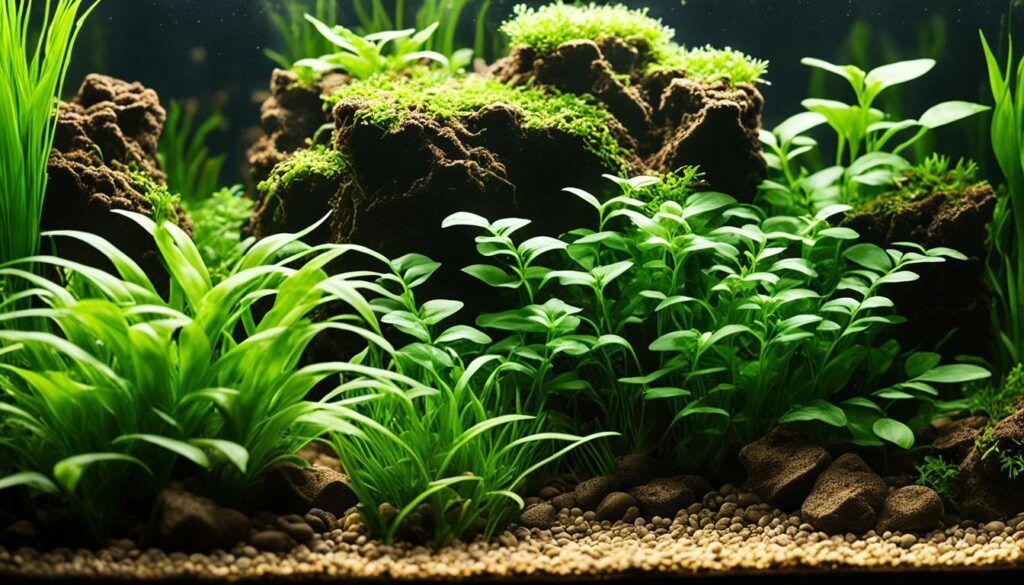
I hope you find this DIY aquarium substrate idea helpful and inspiring. Stay tuned for more exciting ideas to enhance your freshwater tank ecosystem!
DIY Aquarium Substrate Idea 2: Clay Cat Litter
Another DIY substrate idea is using plain clay cat litter. Rinsing the clay cat litter thoroughly to remove any dust or unwanted particles is an essential step. It’s important to use unscented litter and avoid litter made from substances like walnut shells or sawdust, as they may contain additives harmful to your tank’s ecosystem. Once rinsed, add the clay cat litter directly to your tank and cover it with sand or gravel. This DIY substrate option can be cost-effective and provide a suitable environment for plant growth.
DIY Aquarium Substrate Idea 3: Garden Soil
Looking for a cost-effective and nutrient-rich substrate for your DIY aquarium? Consider using garden soil. It’s a natural option that provides a suitable environment for growing live plants in your tank.
To get started, make sure to source and prepare the garden soil properly. Remove any wood, rocks, or insects that may be present. You want to ensure a clean and safe substrate for your aquarium.
Once you have the soil ready, sieve it to achieve the desired texture. This step will help remove any larger particles that could cloud the water or hinder plant growth. Drying the soil is also essential to prevent excessive moisture in the aquarium.
Once prepared, you can add the garden soil to your tank as substrate. Cover it with a layer of gravel or sand for a polished look. The nutrient-rich soil will provide essential elements for plant growth, contributing to a vibrant and healthy aquatic environment.
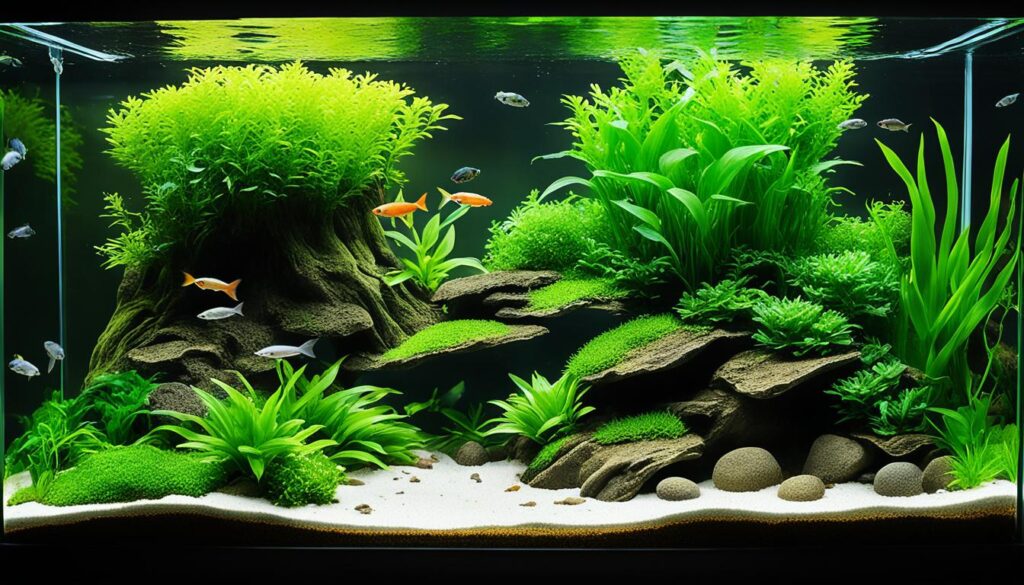
| Pros | Cons |
|---|---|
| Cost-effective | May contain pests or unwanted debris |
| Nutrient-rich | Requires proper sourcing and preparation |
| Suitable for live plants | May need occasional supplementation |
A table summarizing the pros and cons of using garden soil as a DIY aquarium substrate:
Pros
- Cost-effective
- Nutrient-rich
- Suitable for live plants
Cons
- May contain pests or unwanted debris
- Requires proper sourcing and preparation
- May need occasional supplementation
By opting for garden soil as your DIY aquarium substrate, you can create a thriving aquatic ecosystem with healthy plants and happy fish.
DIY Aquarium Substrate Idea 4: Backyard Soil
Another option for DIY aquarium substrate is using soil from your own backyard. By sieving the soil to remove any unwanted debris and drying it thoroughly, you can create a substrate that is eco-friendly and suitable for your aquarium. This DIY substrate idea ensures that you’re using natural materials and returning them to nature when needed.
Backyard soil is an excellent choice for DIY aquarium substrate, offering a cost-effective and sustainable solution for your freshwater tank. It is readily available, allowing you to utilize resources from your own property. By incorporating backyard soil into your aquarium, you can create an eco-friendly environment while promoting the well-being of your aquatic plants and fish.
To prepare backyard soil for your aquarium, it’s important to follow a sieving process to remove any undesirable elements. Start by collecting a sufficient amount of soil from your yard, ensuring it is free from contaminants such as pesticides or fertilizers. Using a fine mesh sieve, carefully sift the soil to separate out any rocks, roots, or other debris that may be present. This process helps create a clean and uniform substrate for your tank.
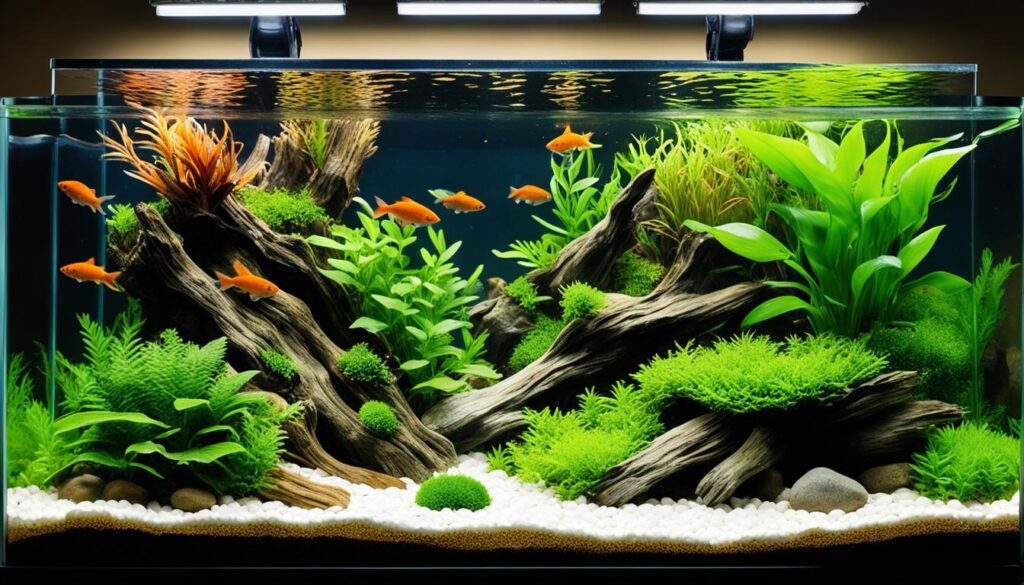
DIY Aquarium Substrate Idea 5: Sand
When it comes to creating a natural-looking environment for your aquarium, sand is a fantastic DIY substrate option. It not only adds visual appeal to your tank but also caters to fish species that prefer to burrow or sift through the substrate. Sand is affordable, versatile, and provides a great foundation for creating an aesthetically pleasing aquarium.
Opting for aquarium-safe sand varieties like pool filter sand or play sand is crucial to ensure the well-being of your fish. These types of sand have been specifically processed and treated to eliminate any harmful substances that may be present in other types of sand. Choosing the right sand will help maintain water quality and prevent any negative impact on your fish and plants.
You can obtain sand for your DIY substrate from various sources. Leftover sand from building projects is a great option, as long as it doesn’t contain any contaminants like cement or chemicals. Another convenient option is to purchase aquarium-specific sand, which is readily available at pet stores or online retailers. These sands are often pre-washed and sifted, making them safe for aquarium use without any additional preparation or cleaning.
Creating a natural environment in your aquarium not only benefits the overall aesthetic appeal but also promotes the well-being of your fish. Many fish species naturally engage in burrowing behaviors, and providing them with an appropriate substrate like sand allows them to express their natural instincts. Additionally, sand provides a soft and comfortable surface for bottom-dwelling fish and invertebrates, enhancing their overall quality of life.
Please note:
It’s essential to ensure that the sand you choose for your aquarium is free from any sharp edges or abrasive particles that could harm your fish or damage their delicate skin. Avoid using beach sand or sand collected from natural bodies of water, as these may contain harmful pathogens, pollutants, or sharp shells that can pose a risk to your aquatic pets.
Incorporating sand into your DIY aquarium substrate not only creates a natural-looking environment but also provides a comfortable and enriching space for your fish to thrive. Its versatility allows you to design and create unique aquascapes, replicating natural habitats for your fish and plants.
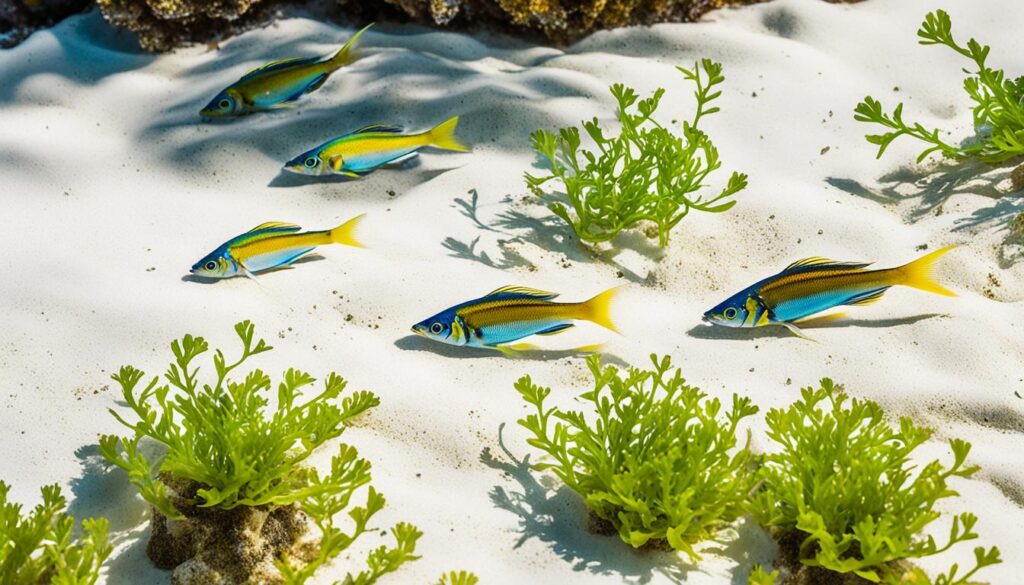
Image shows a fish burrowing in sand, demonstrating the natural behavior encouraged by this substrate option.
| Advantages of Sand as DIY Aquarium Substrate | Considerations |
|---|---|
|
|
Things to Avoid in DIY Substrates
While creating your own DIY substrate can be a cost-effective and customizable option for your freshwater tank, there are certain things you should avoid to maintain a healthy environment for your aquatic plants and animals. Here are a few key substances and materials to steer clear of:
- Peat: While peat can be beneficial for lowering pH levels, it should only be used if reducing acidity is your goal.
- Dyes: Avoid using substrates that contain dyes, as they can leach harmful chemicals into the water and negatively affect your tank’s ecosystem.
- Scents: Fragrances or scented materials may seem appealing, but they can be toxic to aquatic life. It’s best to choose unscented substrates to ensure the well-being of your tank’s inhabitants.
- Pesticides and Fungicides: Substrates that contain pesticides or fungicides can have detrimental effects on the overall health of your aquarium. Ensure that the materials you use are free from these harmful chemicals.
- Cleaning Chemicals: Avoid using substrates that have been treated with cleaning chemicals, as they can harm your aquatic plants and animals. Opt for natural, chemical-free materials instead.
By avoiding these substances and materials, you can create a DIY substrate that promotes a thriving and balanced ecosystem in your freshwater tank.
Benefits of DIY Substrate for Freshwater Tanks
Creating DIY substrates for freshwater tanks offers several benefits. Let’s take a closer look at how DIY substrate can be a cost-effective and customizable solution for your aquarium.
Cost-Effective:
One of the major advantages of DIY substrate is its cost-effectiveness. Instead of purchasing pre-made substrates, creating your own allows you to save money and allocate your budget to other aspects of your aquarium setup, such as filtration systems or lighting.
Customization:
DIY substrate provides you with the opportunity to customize your tank according to your preferences and the specific needs of your aquarium. You can experiment with different materials, textures, and colors to create a substrate that complements your tank’s design and enhances the overall visual appeal.
Healthier Aquarium:
By carefully selecting and preparing the materials for your DIY substrate, you can create a healthier environment for your aquarium livestock and plants. Homemade substrates often contain fewer chemicals and pollutants compared to pre-made options, which can positively impact the well-being and longevity of your aquatic ecosystem.
Additionally, DIY substrates can encourage the growth of beneficial bacteria that help maintain water quality and create a stable biological balance in the tank.
“DIY substrates promote a cost-effective and customizable approach to freshwater tanks, resulting in healthier aquariums for your aquatic creatures.”
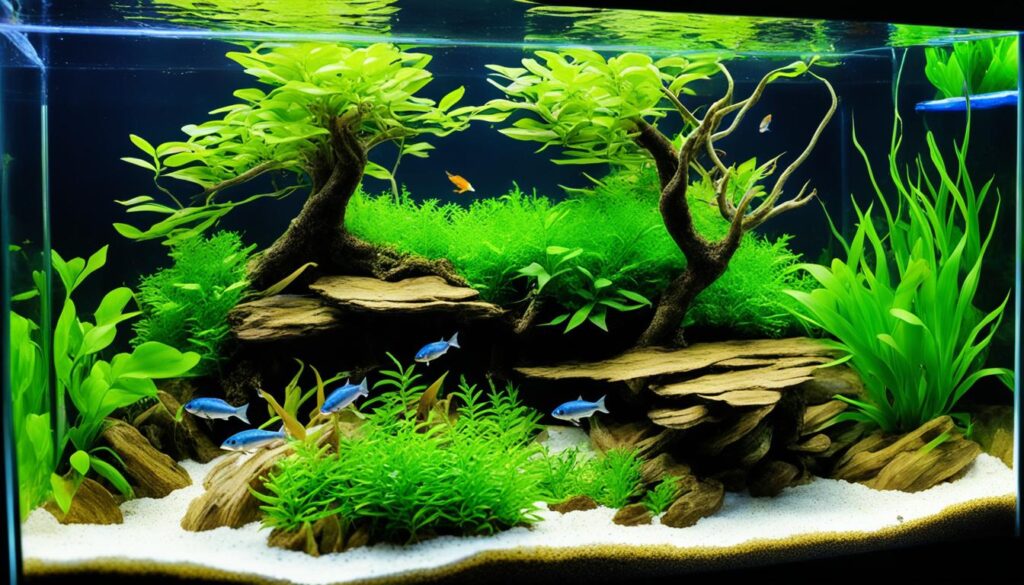
Overall, DIY substrates offer a range of benefits, including cost-effectiveness, customization options, and a healthier environment for your aquarium. By taking the time to create a DIY substrate that suits your tank’s specific needs, you can provide optimal conditions for your aquatic life while enjoying the satisfaction of a project completed with your own hands.
Tips for Maintaining DIY Substrates in Freshwater Tanks
Maintaining DIY substrates in freshwater tanks is essential for the health and longevity of your aquarium ecosystem. By following these tips, you can ensure that your substrate remains effective and provides a suitable environment for your fish and plants.
Regular Monitoring
Regularly monitoring the water parameters in your tank is crucial for maintaining a stable and healthy environment. Test the pH, ammonia, nitrite, and nitrate levels regularly to detect any imbalances that may affect your substrate. Monitoring the water quality will allow you to address any issues promptly and prevent them from impacting the well-being of your aquatic life.
Proper Cleaning
Proper cleaning of your DIY substrate is essential for removing debris and preventing the build-up of harmful substances. Use a gravel vacuum during routine water changes to remove any uneaten food, waste, and other organic matter that may accumulate in the substrate. Regular cleaning will help maintain water clarity and prevent water quality issues.
Preventive Measures
Implementing preventive measures can help maintain the effectiveness of your DIY substrate. Avoid overfeeding your fish, as excess food can lead to waste accumulation and nutrient imbalances in the tank. Regularly monitor the health of your fish and address any signs of disease or stress promptly. Performing routine maintenance tasks, such as cleaning filters and checking equipment, will contribute to the overall health of your aquarium ecosystem.
“Regular monitoring and proper cleaning are essential for maintaining DIY substrates in freshwater tanks. By taking preventive measures, you can ensure a thriving and healthy environment for your aquatic life.” – Your Name
| Tip | Description |
|---|---|
| Regular Monitoring | Test water parameters to maintain a stable environment. |
| Proper Cleaning | Use a gravel vacuum for routine substrate cleaning during water changes. |
| Preventive Measures | Avoid overfeeding, monitor fish health, and perform routine maintenance. |
By following these tips for maintaining DIY substrates in freshwater tanks, your aquarium will thrive with a healthy and vibrant ecosystem. Regular monitoring, proper cleaning, and preventive measures will contribute to the long-term success of your DIY substrate and provide a suitable habitat for your aquatic life.
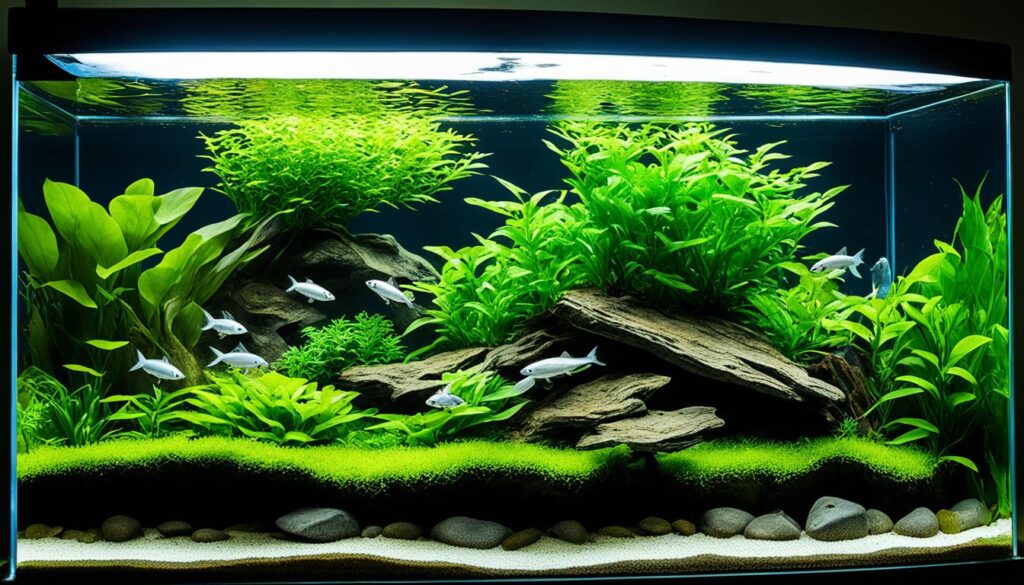
Conclusion
In conclusion, DIY substrate ideas offer a cost-effective and customizable solution for freshwater tanks. By following the steps and selecting the right materials, you can create a natural environment that promotes the well-being of your fish and plants. DIY substrates not only save you money but also provide numerous benefits for your aquarium ecosystem.
One of the major advantages of DIY substrates is their cost-effectiveness. Instead of purchasing pre-made substrates, which can be expensive, you can create your own using readily available materials. This allows you to allocate your budget wisely and invest in other aspects of your aquarium setup.
Furthermore, DIY substrates enable you to customize your tank to suit your preferences and the specific needs of your fish and plants. You can adjust the composition and texture of the substrate to provide the ideal conditions for plant growth and enhance the natural appearance of your aquarium.
By creating a healthier environment for your aquarium, DIY substrates can significantly contribute to the overall well-being of your freshwater tank. They provide a natural habitat for your fish and help establish a balance in the tank’s ecosystem. With proper maintenance and regular monitoring, DIY substrates can support the thriving of your aquatic life and ensure a visually appealing and sustainable freshwater tank.
FAQ
What is the purpose of substrate in freshwater tanks?
Substrate supports plant growth, provides a surface for beneficial bacteria colonization, and enriches the environment for aquarium livestock.
How do I create a topsoil and clay mixture DIY substrate?
Soak the topsoil in water, remove excess fertilizers, dry the topsoil, mix it with potter’s clay and water to form a thick batter-like texture, and add the mixture to your tank, covering it with gravel or sand.
Can I use clay cat litter as a DIY substrate for my freshwater tank?
Yes, rinse clay cat litter thoroughly to remove dust or unwanted particles, ensure it is unscented and not made from substances like walnut shells or sawdust, then add it directly to your tank and cover it with sand or gravel.
Is garden soil a suitable DIY substrate option for freshwater tanks?
Yes, garden soil can be used as a cost-effective option that is already rich in nutrients. Properly source and prepare the soil, removing wood, rocks, and insects. Sieve the soil for desired texture, dry it, and then use it in your aquarium as substrate.
Can I use soil from my own backyard as a DIY substrate?
Yes, by sieving and drying the soil thoroughly, you can create an eco-friendly substrate for your freshwater tank.
What are the benefits of using sand as a DIY aquarium substrate?
Sand is an affordable and versatile option that creates a natural-looking environment suitable for fish species that prefer to burrow or sift through the substrate.
What should I avoid when creating DIY substrates?
Avoid using substrates that contain peat, dyes, scents, cleaning chemicals, pesticides, or fungicides, as they can be harmful to aquatic plants and animals.
What are the benefits of DIY substrate for freshwater tanks?
DIY substrates are cost-effective, customizable, and provide a healthier environment for aquarium livestock and plants.
How do I maintain DIY substrates in freshwater tanks?
Regularly monitor water parameters, perform necessary water changes, vacuum the substrate to remove debris, and avoid overfeeding fish to prevent waste accumulation.
What are the benefits of DIY substrate ideas for freshwater tanks?
DIY substrate ideas provide a cost-effective and customizable solution, create a natural environment, and contribute to a healthier aquarium ecosystem.
